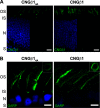The GARP Domain of the Rod CNG Channel's β1-Subunit Contains Distinct Sites for Outer Segment Targeting and Connecting to the Photoreceptor Disk Rim
- PMID: 33637563
- PMCID: PMC8026354
- DOI: 10.1523/JNEUROSCI.2609-20.2021
The GARP Domain of the Rod CNG Channel's β1-Subunit Contains Distinct Sites for Outer Segment Targeting and Connecting to the Photoreceptor Disk Rim
Abstract
Vision begins when light is captured by the outer segment organelle of photoreceptor cells in the retina. Outer segments are modified cilia filled with hundreds of flattened disk-shaped membranes. Disk membranes are separated from the surrounding plasma membrane, and each membrane type has unique protein components. The mechanisms underlying this protein sorting remain entirely unknown. In this study, we investigated the outer segment delivery of the rod cyclic nucleotide-gated (CNG) channel, which is located in the outer segment plasma membrane, where it mediates the electrical response to light. Using Xenopus and mouse models of both sexes, we now show that the targeted delivery of the CNG channel to the outer segment uses the conventional secretory pathway, including protein processing in both ER and Golgi, and requires preassembly of its constituent α1 and β1 subunits. We further demonstrate that the N-terminal glutamic acid-rich protein (GARP) domain of CNGβ1 contains two distinct functional regions. The glutamic acid-rich region encodes specific information targeting the channel to rod outer segments. The adjacent proline-enriched region connects the CNG channel to photoreceptor disk rims, likely through an interaction with peripherin-2. These data reveal fine functional specializations within the structural domains of the CNG channel and suggest that its sequestration to the outer segment plasma membrane requires an interaction with peripherin-2.SIGNIFICANCE STATEMENT Neurons and other differentiated cells have a remarkable ability to deliver and organize signaling proteins at precise subcellular locations. We now report that the CNG channel, mediating the electrical response to light in rod photoreceptors, contains two specialized regions within the N terminus of its β-subunit: one responsible for delivery of this channel to the ciliary outer segment organelle and another for subsequent channel sequestration into the outer segment plasma membrane. These findings expand our understanding of the molecular specializations used by neurons to populate their critical functional compartments.
Keywords: CNG channel; cilium; membrane trafficking; outer segment; photoreceptor.
Copyright © 2021 the authors.
Figures







Similar articles
-
Ankyrin-G promotes cyclic nucleotide-gated channel transport to rod photoreceptor sensory cilia.Science. 2009 Mar 20;323(5921):1614-7. doi: 10.1126/science.1169789. Science. 2009. PMID: 19299621 Free PMC article.
-
The cGMP-gated channel and related glutamic acid-rich proteins interact with peripherin-2 at the rim region of rod photoreceptor disc membranes.J Biol Chem. 2001 Dec 21;276(51):48009-16. doi: 10.1074/jbc.M108941200. Epub 2001 Oct 18. J Biol Chem. 2001. PMID: 11641407
-
Organization of cGMP sensing structures on the rod photoreceptor outer segment plasma membrane.Channels (Austin). 2014;8(6):528-35. doi: 10.4161/19336950.2014.973776. Channels (Austin). 2014. PMID: 25616687 Free PMC article.
-
Cyclic GMP-gated channel and peripherin/rds-rom-1 complex of rod cells.Novartis Found Symp. 1999;224:249-61; discussion 261-4. doi: 10.1002/9780470515693.ch14. Novartis Found Symp. 1999. PMID: 10614055 Review.
-
Tuning outer segment Ca2+ homeostasis to phototransduction in rods and cones.Adv Exp Med Biol. 2002;514:179-203. doi: 10.1007/978-1-4615-0121-3_11. Adv Exp Med Biol. 2002. PMID: 12596922 Review.
Cited by
-
Investigation of ABCA4 Missense Variants and Potential Small Molecule Rescue in Retinal Organoids.Invest Ophthalmol Vis Sci. 2025 Jul 1;66(9):58. doi: 10.1167/iovs.66.9.58. Invest Ophthalmol Vis Sci. 2025. PMID: 40693713 Free PMC article.
-
Determinants shaping the nanoscale architecture of the mouse rod outer segment.Elife. 2021 Dec 21;10:e72817. doi: 10.7554/eLife.72817. Elife. 2021. PMID: 34931611 Free PMC article.
-
Dysregulated Arginine Metabolism Is Linked to Retinal Degeneration in Cep250 Knockout Mice.Invest Ophthalmol Vis Sci. 2023 Sep 1;64(12):2. doi: 10.1167/iovs.64.12.2. Invest Ophthalmol Vis Sci. 2023. PMID: 37656476 Free PMC article.
-
Compartmentalization of Photoreceptor Sensory Cilia.Front Cell Dev Biol. 2021 Feb 4;9:636737. doi: 10.3389/fcell.2021.636737. eCollection 2021. Front Cell Dev Biol. 2021. PMID: 33614665 Free PMC article. Review.
-
Retrospective Natural History Study of RPGR-Related Cone- and Cone-Rod Dystrophies While Expanding the Mutation Spectrum of the Disease.Int J Mol Sci. 2022 Jun 28;23(13):7189. doi: 10.3390/ijms23137189. Int J Mol Sci. 2022. PMID: 35806195 Free PMC article.
References
Publication types
MeSH terms
Substances
Grants and funding
LinkOut - more resources
Full Text Sources
Other Literature Sources
Molecular Biology Databases
